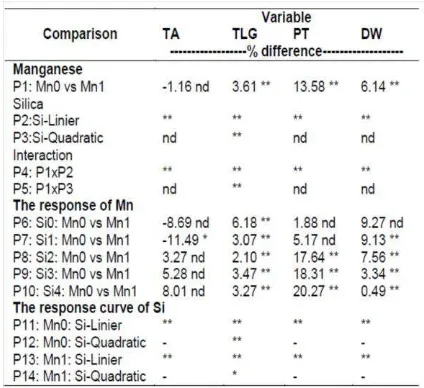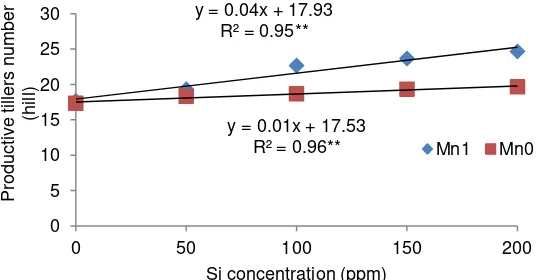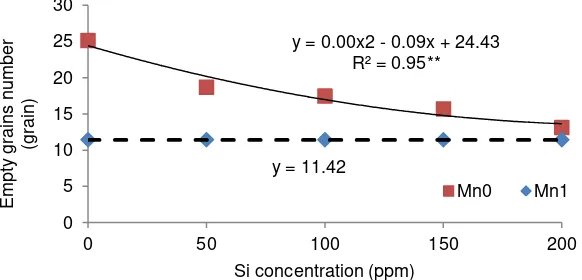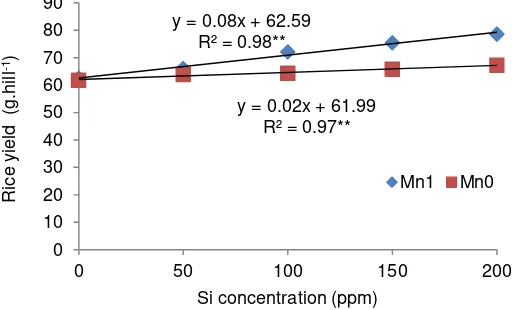http://dx.doi.org/10.17503/Agrivita-2014-36-2-p182-188
THE EFFECT OF SILICA AND MANGANESE APPLICATION ON RICE
GROWTH AND YIELD
Paul Benyamin Timotiwu*) and Maya Maeistia Dewi
Faculty of Agriculture University of Lampung
Jl. Sumantri Brojonegoro No.1 Bandar Lampung 35145 Bandar Lampung Indonesia *)
Corresponding author Phone: +62-8154039127 E-mail: [email protected]
Received: May 15, 2014 / Accepted: August 7, 2014
ABSTRACT
The application of silica and manganese through the leaves can be directly absorbed by the rice plants for growth and yield. This study aimed to determine the effect of the increasing silica and manganese concentration and their interaction on plant growth and rice yield. The greenhouse research was conducted in the Seed and Plant Breeding Laboratory, Agriculture Faculty, Lampung University from June–September 2013. The treatments were arranged in a 5x2 factorial consisting of five concentrations of Si [(0, 50, 100, 150, and 200 ppm), and two concentrations of Mn (0 and 5ppm)] in a randomized complete block design with three replications. The results showed that increasing concentration of Si increased the green of leaves, the number of productive tillers, dry weight, filled grains number, and decreased angle of the tiller and the number of empty grains. The application of Mn increased the growth and rice yield, except angle of tillers and the number of empty grains. In addition, the effect of Mn depended on the level of Si concentration. Application of Mn with increasing Si concentration increased plant growth and rice yield.
Keywords: manganese, rice, silica
INTRODUCTION
Rice crops (Oryza sativa L.) is a producer of staple food as a source of carbohydrate for most of the world's population. In Indonesia, almost 95% of the population consumes rice as the staple food. Every year the demand for rice is increasing with the increase of population. On the other hand, the increase of rice yield is
stagnant which mandates an effort to increase the yield to meet the demand for rice.
Indonesia has sought to increase yield of rice through many ways, one of which is intensification cultivation through fertilization. Fertilization is the provision of materials, both to the soil and the plants intended to supplement for the nutrients that can improve soil fertility and increase the quantity and quality of crops (Thompson and Troeh, 2005).
During the growth period, rice plants require a balanced nutrition to support their survival. In addition to macro nutrients, there are several other micro nutrients, such as silica (Si), which is also beneficial to the rice crop. Some studies suggested that Si has some important roles to the rice crop. The application of Si improves yields through increased efficiency of photosynthesis and induces resistance to pests and diseases (Makarim et al., 2007).
Another essential micro nutrient, manganese (Mn) is also beneficial for the growth of rice. Manganese plays a role in the physiological processes in plants as an activator of several enzymes and a catalisator in splitting water molecules during photolysis process of photosynthesis (Gardner et al., 1985; Humphrise, 2006; and Aref, 2012). According to Sutedjo (2008) and Agustina (2011), Mn could maintain the condition of the green leaves, especially on older leaves. With an addition of Mn, the old leaves were expected to be able to photosynthesize which resulted in the increase of yield potential.
Both Si and Mn are expected to directly increase the production of rice in order that the rice demand could be met. This study aimed to determine the effect of increasing concentration of silica and manganese, as well as their interaction on the rice growth and yield.
183
Paul Benyamin Timotiwu: The Effect of Silica and Manganese Application……….
MATERIALS AND METHODS
The research was conducted in the Green-house of the Seed and Plant Breeding Labo-ratory, Faculty of Agriculture, University of Lampung from June–September 2013.
The materials used were Mekonggarice variety, urea, SP-18, KCl, distilled water, silica (SiO2), manganese (MnSO4.4H2O), chloro-bromo acid 50%, Fipronyl 50 g l-1, and Fenobukarb 500 g l-1. The laboratory instruments used were electronic scales with 0.01 g sensitivity, measuring cups, measuring flask, plastic bucket, hand sprayer, Konica Minolta SPAD 502 series chlorophyll meter, gauge, protractor, oven, and seed blower.
The treatments were arranged in factorial with five concentrations of Si and two concentrations of Mn. The study was conducted in a randomized complete block design with three replications. The first factor is the five concentration of Si, 0 ppm Si (Si0), 50 ppm Si (Si1), 100 ppm Si (Si2), 150 ppm Si (Si3), and 200 ppm Si (Si4). The second factor was the two concentrations of Mn, 0 ppm Mn (Mn0) and 5 ppm Mn (Mn1). There were 30 experimental plots altogether.
The micronutrient Si and Mn were applied three times started on day 21 after planting with a 4 week interval. The applications were done in the morning from 9:00―11:00 pm. The treatment was applied to the entire surface of the leaves of rice plants. The Si and Mn were applied on the same day, and Mn was first applied to the rice leaves, followed by Si.
Observed variables on the plant growth and yield of rice were the green level of leaf, angle of tillers, number of productive tillers, dry weight, number of filled grains, number of empty grains, and yield. Data were then analyzed using Orthogonal Contrast and Polynomial for Mn and Si. The entire test was done at the level
α of 5% and 1%.
RESULTS AND DISCUSSION
The results of study showed that rice plants were responsive to the increasing concentration levels of Si and Mn. Polynomial analysis on the level α of 5% and 1% presented in Table 1 and 2 shows that there was an interaction between concentration of Si and Mn
concentration of Si to 200 ppm with addition of 5 ppm Mn showed the best response of rice plants in all variables, except the angle of tillers and number of empty grains. This was caused by the differences between mobilization and distribution of Si and Mn in the plant tissues. Distribution and mobilization of Si in the plant tissues was faster and easier than those of Mn (Humphrise, 2006). In the leaf tissues, Mn was relatively immobile and accumulated in the leaf tissues of rice plants. In addition, Si was distributed faster to the rice stem lignin bound to the components of the cell wall. Silica bound into the cell wall caused rice seedling angle to become more upright without the presence of Mn (Figure 1).
Table 1. Recapitulation effect of an increase in the concentration of Si and the addition of Mn on the rice growth
Remarks: Mn0= 0 ppm Manganese; Mn1= 5 ppm Manganese; Si0= 0 ppm Silica; Si1= 50 ppm Silica; Si2= 100 ppm Silica; Si3= 150 ppm Silica; Si4= 200 ppm Silica; TA= angle of tillers; TLG= the level of greenness of leaves; PT= productive tillers number; DW= dry weight. * and ** significant at α = 5% and 1%, nd= not significant at α = 5%
Paul Benyamin Timotiwu: The Effect of Silica and Manganese Application………
Table 2. Recapitulation of the effect of an increase in the concentration of Si and the addition of Mn on rice yield
Comparison
The response curve of Si
P11:Mn0:Si-Linier ** ** ** number; RY= rice yield. * and ** significant at α = 5% and 1%, nd= not significant at α efficient absorption of sunlight for photo-synthesis. The increased efficiency in the absorption of sunlight permitted photosynthetic activity to proceed smoothly.
When sunlight was absorbed by the leaves, a photolysis process of splitting water molecules happened. Millaleo et al. (2010) mentioned that the role of Mn as a catalyst in the photolysis process would indirectly increase the activity of photo-synthesis. Increased photosynthetic activity affected the concentration of chlorophyll in the leaf tissues. Chlorophyll concentration determined leaf green index measured as SPAD value. The greater the chlorophyll concentration was, the greater the value of SPAD would be, which measured the greater leaf green level. The result showed that the addition of 5 ppm Mn increased the green enhancing photosynthetic activity through increasing the concentration of chlorophyll. These conditions made the leaves remain green even though they were at senescence age.
The positive effects of increased concen-trations of Si and Mn applications on the rice plants were also evident from the increase in the number of productive tillers (Figure 3) and dry weight (Figure 4). The increasing concentration to 200 ppm accompanied by the addition of 5 ppm Mn increased organic compounds synthesized by plants through the increased photosynthesis. This synthesis produced starches, lipids, and proteins which were used by the plant for the division plant tissues in order to increase their dry weight. Junior et al. (2010) found that the addition of 2 mmol l-1 accompanied by an increase in Mn
185
Paul Benyamin Timotiwu: The Effect of Silica and Manganese Application……….
Figure 1. Relationship between elevated concentrations of Si with and without Mn on angle of tillers
Figure 2. Relationship between elevated concentrations of Si with and without Mn on the level of greenness of leaves
Figure 3. Relationship between elevated concentrations of Si with and without Mn the number of y = 0.04x + 17.93
R² = 0.95**
y = 0.01x + 17.53 R² = 0.96**
0 5 10 15 20 25 30
0 50 100 150 200
Pro
du
cti
ve
ti
lle
rs
n
um
be
r
(h
ill
)
Si concentration (ppm)
Mn1 Mn0 y = -0.02x + 20.48
R² = 0.85**
y = -0.04x + 22.60 R² = 0.96**
0 5 10 15 20 25
0 50 100 150 200
An
gl
e
of
til
le
rs
(0
)
Si concentration (ppm)
Mn1 Mn0
y = 0.01x + 36.86 R² = 0.96**
y = 0.01x + 35.12 R² = 0.80**
30 31 32 33 34 35 36 37 38 39 40
0 50 100 150 200
T
he
le
ve
l o
f g
re
en
ne
ss
o
f l
ea
ve
s
(SPAD)
Si concentration (ppm)
Figure 4. Relationship between elevated concentrations of Si with and without Mn on dry weight
Figure 5. Relationship between elevated concentrations of Si with and without Mn on the number of filled grains
Figure 6. Relationship between elevated concentrations of Si with and without Mn on the number of empty grains
y = 0.07x + 96.20 R² = 0.97**
y = 0.02x + 95.20 R² = 0.97**
0 50 100 150
0 50 100 150 200
Dry
w
ei
gh
t (g
)
Si concentration (ppm)
Mn1 Mn0
y = 0.00x2 - 0.09x + 24.43 R² = 0.95**
y = 11.42
0 5 10 15 20 25 30
0 50 100 150 200
Em
pty
g
ra
in
s
nu
m
be
r
(g
ra
in
)
Si concentration (ppm)
Mn0 Mn1
y = 4,0593x + 2537,1 R² = 0,944
y = 1,6331x + 2395,9 R² = 0,954
0 500 1000 1500 2000 2500 3000 3500 4000
0 50 100 150 200
Fi
lle
d
gra
in
s
nu
m
be
r
(g
ra
in
)
Si concentration (ppm)
187
Paul Benyamin Timotiwu: The Effect of Silica and Manganese Application……….
Figure 7. Relationship between elevated concentrations of Si with and without Mn on rice yield
Increasing assimilated products as an indicator of photosynthetic efficiency improvement due to the increased concentration of Si and Mn addition increased the number of filled grains (Figure 5). Assimilated products of photosyn-thesis translocated from the leaves into the grain to increase the number of filled grains. The increasing number of filled grains and the reducing number of empty grains were shown at Figure 6. Increasing the number of filled grains led to an increase in rice production (Figure 7).
Overall, the results demonstrated that the interaction between the Si and Mn increased the growth and production of rice. Concentration of Si with Mn application increased the efficiency of photosynthesis beneficial to rice yield and growth.
CONCLUSIONS AND SUGGESTION
CONCLUSSIONS
The increase of Si concentration to 200 ppm increased the green level of leaves, the number of productive tillers, dry weight, the number of filled grains, and rice yield, and reduced the angle of tillers and the number of empty grains.
The addition of 5 ppm Mn increased the growth and rice yield when compared to without Mn as indicated by all variables, except the angle of tillers and the number of empty grains.
Rice growth and yield increased with the increasing concentration of Si with the addition of 5 ppm Mn.
SUGGESTION
To support the efforts to increase rice production, the research toward limiting factors such as the environment is necessary. Since this study was done in a greenhouse, environmental factors could be controlled in a good fashion, so that the results obtained were not able to describe the yield significantly compared to the study conducted in the field. Therefore, similar field study on rice needs to be done to obtain more realistic results.
ACKNOWLEDGEMENTS
Many thanks are addressed to Dr. Ir. Saiful Hikam, M.Sc., Lampung University for manuscript correction of and final improvement of the language.
REFERENCES
Agustina, L. 2011. Micro nutrient I (Fe, Mn, Zn, Cu, B, Mo dan Cl) importance of nutrient deficiency and toxicity (in Indonesian). Post-Graduate Program University of Brawijaya. Malang. p. 25-32.
Aref, F. 2012. Manganese, iron, and copper contents in leaves of maize plant (Zea mays L.) grown with different boron and zinc micronutrients. African Journal of Biotechnology 11(4): 896‒903.
Gardner, F.P., R.B. Pearce and R.L. Mitchell. 1985. Physiology of crop plants. The Iowa State University Press. Iowa. p. 98‒129. y = 0.08x + 62.59
R² = 0.98**
y = 0.02x + 61.99 R² = 0.97**
0 10 20 30 40 50 60 70 80 90
0 50 100 150 200
Ric
e
yi
el
d
(g
.hill
-1)
Si concentration (ppm)
Humphrise, J.M. 2006. Handbook of plant nutrition. Edited by Allen V. Barker and David J. Pilbeam. CRC Press. New York. p. 351‒366.
Júnior, L.A.Z., R.L.F. Fontes, J.C.L. Neves, G.H.
Korndörfer and V.T. de Ávila. 2010.
Rice grown in nutrient solution with doses of manganese and silicon. R. Bras. Ci Solo.34: 1629‒1639.
Makarim, A.K., E. Suhartatik and A. Kartohardjono. 2007. Silicon: Essential nutrient in the system of rice production (in Indonesian). Science and Technology (IPTEK) in Crops. 2 (2):
195‒204.
Maksimovic´, J.D., M. Mojovic´, V. Maksimovic´, V. Römheld and M. Nikolic. 2012. Silicon ameliorates manganese toxicity in cucumber by decreasing hydroxyl radical accumulation in the leaf apoplast. Journal of Experimental Botany: 1‒10. Millaleo, R., M. Reyes-Díaz, A.G. Ivanov, M.L.
Mora and M. Alberdi. 2010. Manganese as essential and toxic element for plants: Transport,
Accumulation and Resistance Mechanisms. Journal of Soil Science Plant Nutrition 10(4): 476‒494.
Salisbury, F.B. and C.W. Ross. 1991. Plant physiology. Fourth Edition. Wadsworth Publishing Company.Belmont, California. p. 207‒224.
Santoz, E.F., B.J. Zanchim, A.G. de Campos, R.F. Garrone and J.L. Junior. 2013. Photosynthesis rate, chlorophyll content, and initial development of physic nut without micronutrient fertilization. R. Bras. Ci.Solo.(37): 1334‒1342.
Sutedjo, M.M. 2008. Fertilizer and how to fertilize (in Indonesian). Rineka Cipta. Jakarta. pp. 177
Taiz, L. and E. Zeiger. 2010. Plant physiology. Fifth Edition. Sinaeur Associates Inc. Massachusetts, USA. p. 161‒397. Thompson, L.M. and F.R. Troeh. 2005. Soil and



